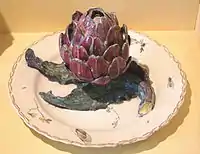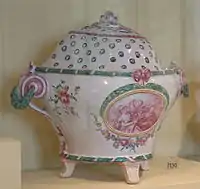Gaspard Robert
Gaspard Robert (1722-1799) was the founder of a factory that made faience in Marseille, France between 1750 and 1793.
 Pitcher with lid, polychrome petit feu decoration. Around 1750 | |
| Founded | 1750 |
|---|---|
| Founder | Gaspard Robertr |
| Defunct | 1793 |
| Headquarters | , France |
| Products | Faïence |
History
Joseph Gaspard Robert first worked in a porcelain factory, and then returned to Marseille in 1750.
Robert operated a factory from about 1750 to 1793.[1] He collaborated with André Estieu, whom his mother had married after being widowed. He took over from 1761, and led the pottery into a prodigious expansion. Married to Marguerite Defléchis, he did not have children and devoted himself entirely to his profession. Receiving numerous disciples, he was constantly expanding. In 1773 he teamed up with John Jacob Dortu from Berlin for the production of porcelain. This production was mainly a range of small objects for use for snacks between meals or for parts of a service.
In 1777 Joseph Gaspard Robert was visited by the Count of Provence, later Louis XVIII of France, who found that he was busily engaged in manufacturing porcelain. His work included large vases decorated with relief work and bouquets of flowers. Entire sets of tableware were being ordered for shipment abroad.[2] His factory exported to Northern Europe and England, where his links with Freemasonry opened opportunities for him. In 1789, he was elected deputy to represent the potters. Faced with the economic crisis of the time, he was forced to cease operations in 1794.
Products
Robert imitated the high-relief decorative style of la Veuve Perrin. He also produced plates with finely painted landscapes in their center, and after 1773 also made porcelain.[3] He used a less formal style derived from the Rouen manufactory, the style rayonnant.[1] The Robert pottery products typically use monochrome sepia, green, pink or blue decorations, or multicolored landscapes, animals, fish or flowers.
Gallery
The Musée de la Faïence de Marseille has an important collection of work by Gaspard Robert.
 Sauce boat
Sauce boat Pot pourri
Pot pourri Tureen
Tureen Baluster vase with handles
Baluster vase with handles Vase, decor in the taste of Salembier, musée des Arts décoratifs et du Design, Bordeaux, France
Vase, decor in the taste of Salembier, musée des Arts décoratifs et du Design, Bordeaux, France
References
Citations
- Campbell 2006, p. 87.
- Jacquemart 1877, p. 577.
- Coutts 2001, p. 119.
Sources
- Campbell, Gordon (2006-11-09). The Grove Encyclopedia of Decorative Arts: Two-volume Set: Two-volume Set. Oxford University Press. ISBN 978-0-19-518948-3. Retrieved 2012-11-29.CS1 maint: ref=harv (link)
- Coutts, Howard (2001). The Art of Ceramics: European Ceramic Design, 1500-1830. Yale University Press. ISBN 978-0-300-08387-3. Retrieved 2012-11-29.CS1 maint: ref=harv (link)
- Jacquemart, Albert (1877). History of the ceramic art: A descriptive and philosophical study of the pottery of all ages and all nations. Scribner. Retrieved 2012-11-29.CS1 maint: ref=harv (link)